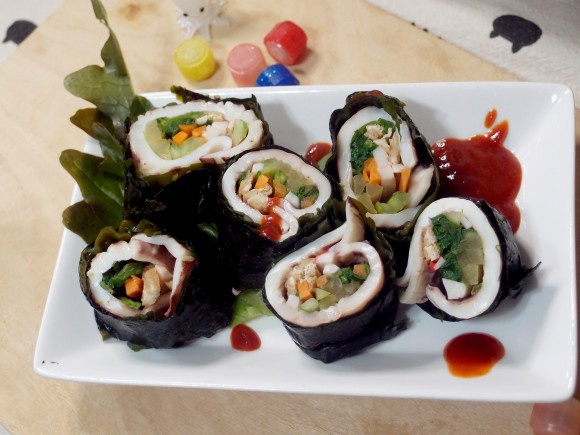Chewy Sea Grapes and Fresh Squid Rolls: A Delicious Combination
#SeaGrapeRecipes #SquidRecipes #HowToMakeSquidRolls #Anju #SquidSeaGrapeRolls

My sister bought me some sea grapes, and since I absolutely love seaweed like miyeok and gompi, I decided to create something special. While they’re delicious dipped in cho-gochujang (spicy red pepper paste with vinegar), eating them plain is often the best! But then, I saw the packaging and got an idea! It was made like kimbap, rolled up with rice and fillings. This gave me an idea: I have a lot of ‘paji’ squid (imperfectly shaped squid, usually cheaper), so why not boil them, add kimbap ingredients, and roll them up in gompi? Since I always have kimbap ingredients at home for lunchboxes, all I needed was to boil the squid. Here’s a unique way to enjoy gompi – Squid and Sea Grape Rolls!
Ingredients- 2 sheets of Gompi (Sea Grapes)
- 2 whole squids (body only)
- 1 Tbsp vinegar (for blanching squid)
- 1 strip of pickled radish (danmuji), julienned
- 1/4 carrot, julienned
- 1/3 cucumber, julienned
- 1 bunch of minari (water parsley), about 1/2 cup
- 1 tsp salt (for seasoning minari)
- 1 tsp sesame oil (for seasoning minari)
- 1 imitation crab stick (surimi), julienned
- 2 sheets of seasoned fried tofu (jo-mi yu-bu), julienned
- 1 sheet of kimbap seaweed (cut in half)
Cooking Instructions
Step 1
First, prepare the minari. Briefly blanch it in boiling water for about 10 seconds. Immediately rinse it under cold water, squeeze out all the moisture, and season with 1 tsp sesame oil and 1 tsp salt. Gently mix well. This preserves the crisp texture and fragrant aroma of the minari.

Step 2
Prepare the fillings for the squid rolls. Along with the seasoned minari from Step 0, julienne the pickled radish, cucumber, imitation crab stick, carrot, and seasoned fried tofu. It’s important to cut all the ingredients into similar thin strips for a neat roll.

Step 3
Clean the salted gompi thoroughly. Place the gompi in cold water and rub it with your hands, rinsing 5-6 times or more until all the salt is removed. Then, soak the gompi in lukewarm water for about 3 minutes, followed by another rinse in cold water. This process helps to remove excess salt and makes the gompi more tender.

Step 4
Lay the prepared gompi flat. Since gompi sheets are long, cut them in half lengthwise to a manageable size for rolling, similar to how you’d prepare nori for kimbap. Use the flatter parts of the gompi for rolling, as the wavy sections might not roll smoothly.

Step 5
Today, we’re using ‘paji’ squid. These are often cheaper and more abundant but just as fresh and delicious as regular squid. Wash them thoroughly under running water.

Step 6
Score the squid bodies diagonally with a knife. This helps them cook evenly and makes for a more pleasant texture. If the squid has tentacles, cut them into pairs to use as filling later, or set aside for another dish like a spicy squid tentacle salad.

Step 7
Time to blanch the squid. Bring a pot of water to a rolling boil and add 1 Tbsp of vinegar. Carefully add the squid bodies and blanch for about 4-5 minutes. Adding vinegar helps to remove any fishy smell and makes the squid firm and tender.

Step 8
Immediately transfer the blanched squid to an ice bath to cool down. Once completely cooled, remove the squid and pat it dry with paper towels. Use the squid bodies whole, without cutting them. This will make for a visually appealing roll.

Step 9
All the components for your Gompi and Squid Rolls are now ready! It’s time to assemble and roll them up into delicious sushi-like wraps.

Step 10
Lay a sheet of gompi flat. Place a whole blanched squid body on top. Arrange the prepared fillings (minari, danmuji, cucumber, imitation crab stick, carrot, fried tofu) attractively over the squid. Be mindful not to overfill, as it can make rolling difficult.

Step 11
First, roll the fillings tightly within the squid. Then, carefully roll the entire thing up using the gompi, just like you would roll kimbap. Since gompi can be slippery, it might be tricky to keep it in place. To help secure the roll, wrap the half-sheet of kimbap seaweed around the outside. The natural sliminess of the gompi will help the seaweed stick well.

Step 12
Carefully slice the finished roll into bite-sized pieces. The white of the squid and the vibrant colors of the fillings create a visually appetizing roll, almost resembling kimbap. If the knife sticks, lightly wet it with water for cleaner cuts.

Step 13
Arrange the sliced Gompi and Squid Rolls attractively on a platter, perhaps over a bed of fresh lettuce leaves. Serve with a side of cho-gochujang for dipping. This rice-less roll is a healthy and delicious alternative to kimbap, perfect for a special meal or a delightful appetizer with drinks.



